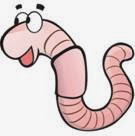The Worms Crawl In, The Worms Crawl Out …
Are you able to finish this tune from childhood? Back then worms gave me the heebie-jeebies, now I adore these animals. My two favorite happen to be the common earthworm that aerates and conditions our soil outside and the Eisenia fetida, also known as (and easier to say), red wigglers.
Originally from Europe, red wigglers are not tunnelers like those beauties I find in my garden soil, but flourish in rotting vegetation and are ideal for a contained system. These special worms create vermicompost which is jam-packed with nutrients.
Tools needed for a worm bin:
• A plastic container with air holes drilled in the bottom and sides
• A pound of red wigglers
• Shredded paper or leaves dampened with de-chlorinated water for bedding
• Fruit and vegetable scraps
Of course there is so much more to learn about vermicomposting and you can find a plethora of information on the web; in the book Worms Eat My Garbage , by Mary Appelhof; or even by attending a worm bin workshop.
Gotta go tend to my vermi-wormies!
Blog post created by Jenny
Are you able to finish this tune from childhood? Back then worms gave me the heebie-jeebies, now I adore these animals. My two favorite happen to be the common earthworm that aerates and conditions our soil outside and the Eisenia fetida, also known as (and easier to say), red wigglers.
Originally from Europe, red wigglers are not tunnelers like those beauties I find in my garden soil, but flourish in rotting vegetation and are ideal for a contained system. These special worms create vermicompost which is jam-packed with nutrients.
Tools needed for a worm bin:
• A plastic container with air holes drilled in the bottom and sides
• A pound of red wigglers
• Shredded paper or leaves dampened with de-chlorinated water for bedding
• Fruit and vegetable scraps
Of course there is so much more to learn about vermicomposting and you can find a plethora of information on the web; in the book Worms Eat My Garbage , by Mary Appelhof; or even by attending a worm bin workshop.
Gotta go tend to my vermi-wormies!
Blog post created by Jenny



I saw something on Amazon.com that I hope was wrong. Worm castings with a NPK of 1-0-0. I was expecting something better than that.
ReplyDelete-Bruce
Bruce, after researching your question, I believe the information above is incorrect. One journal states, "...most vermicompost has 5 to 11 times more nitrogen, calcium, magnesium, phosphorus and potassium than regular soil." Others support this. I also learned it is a slow release fertilizer, unlike synthetic fertilizers, so by law the ratio only considers what is immediately released.
Delete